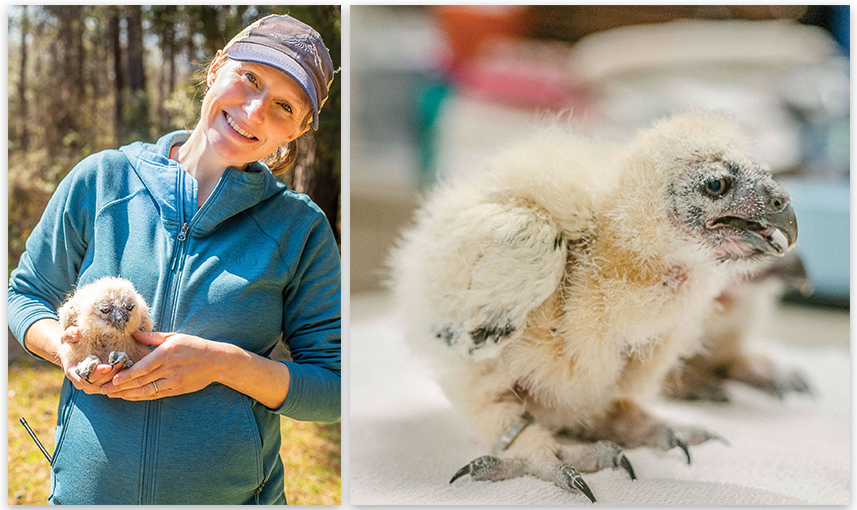The nonprofit breeds the birds for education and to help propagate the species

With four square meals a day, incubators to keep them warm, and no prey around, owlets in the center’s breeding program, like this spectacled hatchling, have a much greater chance of survival than in the wild.
Stephen Schabel was wrapping up his presentation on vultures at a packed amphitheater at the Center for Birds of Prey on a recent morning when, as if on cue, the audience seemed to emit a collective “whoa!” Forget the vulture, the next raptor in the demo lineup, a regal brown and white Ural owl, had arrived.
If vultures are the Rodney Dangerfield of raptors, owls are Rihanna. “People want to see owls; they love owls,” says Schabel, who just marked his 20th year as the center’s director. “A lot of that relates to the fact that they are so mysterious. They have a mystique.” And this particular gal didn’t disappoint her audience, showing off with a low fly-by across the crowd and posing majestically on a perch while visitors strained for good camera angles like paparazzi.
The Ural is one of 40 owls out of the 115 birds of prey that are part of the center’s education program—others include eagles, hawks, falcons, kites, and vultures—which promotes wonderment, as well as public awareness about the threats to raptors, such as car collisions and poison. In addition to the center’s Avian Medical Clinic, which treats some 1,000 birds each year (the most common species of which is the barred owl), the nonprofit has another mission: to breed certain birds in captivity, whether for education or propagation of the species. And that means, each spring brings an average of six owls into the center’s family.

(Left) Husbandry and propagation manager Audrey Ray cares for the hatchlings, including taking them home with her at night. After a steady diet of pinky mice, the owls will reach their full weight at six weeks. ; (Right) This spring, the center welcomed two spectacled owls (above) and two Asian brown wood owls with faces only a mother could love.
Clear across the campus from the flight demo amphitheater at the clinic, the latest couple of owlets—with their cartoonish velociraptor heads, not quite camera-ready—squeak and hobble, craning their necks to reach bits of lunch prepared by husbandry and propagation manager Audrey Ray. At two weeks old, these Asian brown wood owls, cousins of our native barred owl, have a voracious appetite, putting away six pinky mice each a day. Ray feeds them via a tweezer four times daily—she even totes them home in their incubator to give them a snack before bedtime—until they’re about four weeks old, when they can eat on their own.
Hand-feeding is an important step in raising education birds in particular. “With owls, we want them to imprint on humans if we want to train them [for demos],” Schabel says. “Most will be what we call dual imprints given that they’re raised not in isolation with humans but around other owls.”
While one out of two owl chicks don’t survive in the wild, the odds in captivity are much higher. “We’re talking about 30 grams of helpless animal, very few feathers; they can’t keep themselves warm, we have to slowly introduce food,” Schabel says. But after six weeks of gorging on pinky mice, they’ll reach their full body weight.
These hatchlings are destined for the center’s breeding program, which is only one of two in the US that houses Asian brown wood owls. The other is a facility in Delaware, with whom they partner with in the breeding and importation of the species. (Most of the breeding here focuses on non-native owls, since native populations are generally healthy.) While none of the owls being bred there are currently threatened, the goal is to build a sustainable stock in case something goes wrong with them in the wild. As examples, Schabel points to peregrine falcons and condors, species that wouldn’t exist if it weren’t for captive propagation. “While they might not be endangered today, we want to be prepared,” he says.
WATCH: Come Spring, Baby Owls Steal The Show At The Birds Of Prey Avian Conservation Center